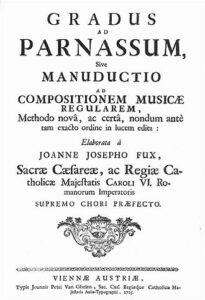If you are studying species counterpoint you are probably aware that there are a lot of rules and that it can be difficult to remember all of them when you attempt to write melodies. I felt it might be useful to compile a summary of the rules to serve as a means to check your work or refresh your memory. I’m assuming that you are attempting to write in common-practice style rather than modal.
Rules That Apply to All Species
- Melodies should be easy to sing, mostly stepwise motion. Don’t use awkward intervals: augmented seconds, tritones, sevenths, ninths and composite leaps in the same direction that result in one of the aforementioned intervals. Leaps in one direction should be followed by stepwise motion in the opposite direction. Bear in mind the vocal range of the voice you are composing for.

- No voice crossing or voice overlaps. Voice crossing is when a lower voice moves above a higher voice. Voice overlap is when a voice crosses beyond where the neighboring voice was one beat before.
- Avoid cross-relations. Example: a note in one voice, e.g. A, is followed by an A# in another voice.
- Begin with perfect consonances: unisons, fifths (above the tonic) or octaves. End with perfect octave or unison.
- No parallel perfect unisons, fifths or octaves.
- No direct perfect consonances. Example: two voices move by similar motion into a perfect unison, fifth or octave. Exception: If the top voice moves by step into the perfect consonance.
- Use the standard cadence for endings: leading tone precedes the tonic in the new voice. Don’t forget to add accidentals to leading tones in minor keys.
First Species in Two Voices
- Note for note: both voices have identical note durations.
- All harmonic intervals must be consonant: perfect unisons, perfect fifths, perfect octaves, major and minor 3rds and 6ths.
- Aside from the opening and closing bars, use perfect consonances sparingly.
- Use parallel 3rds and 6ths sparingly.
Second and Third Species in Two Voices
- In second species the new voice has two notes for each note in in the cantus.
- In third species the new voice has four notes for each note in the cantus.
- Harmonic intervals on strong beats or strong parts of beats must be consonant. See Rule 2. in first species.
- Harmonic intervals on weak beats or weak parts of beats may be consonant or dissonant.
- Dissonant harmonic intervals must be approached and left by step.
- The new voice may open with a rest but it must a perfect consonance. Don’t use rests after that. It defeats the purpose of the exercise.
- Don’t immediately repeat a note. It defeats the purpose of the exercise.
Fourth Species in Two Voices
- The new voice is syncopated in relation to the cantus. You may begin with a rest that is half the duration of the cantus note but the duration of the new voice note should be the same as the cantus note.
- The harmonic interval on the weak beat or weak part of the beat must be consonant.
- The harmonic interval on the weak beat or weak part of the beat may be consonant or dissonant. If dissonant it must resolve down by a step to a consonance. Exception: the leading tone and chromatically raised notes may resolve upward. Don’t resolve leading tones upward if the new voice is below the cantus.
- You may use second species briefly to set up more suspensions.
- In the standard cadence for fourth species the new voice creates a suspension by moving from tonic-leading tone-tonic while the cantus moves from the supertonic to the tonic.
Fifth Species in Two Voices
- Use forward rhythms and ties. Longer notes on strong beats or parts of beats.
- Strive for coherence, direction and growth to one main climax.
- Though any cadence is allowed, the fourth species cadence is most common.
